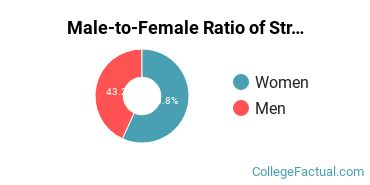 by our College Data Analytics Team
by our College Data Analytics TeamWomen make up 56.8% of the total graduate student body at Strayer University - Global Region while men make you 43.2%. These percentages may be different for specific degree programs.

About 59.6% of the graduate students who attend Strayer University - Global Region are from a racial-ethnic minority group*. Americans aren't the only ones who appreciate the graduate programs at Strayer University - Global Region. Around 0.1% of graduate students are international. The following chart shows the distribution of racial-ethnic groups at the school. If you click on it, you'll find more detailed information.

The average tuition and fees for graduate students is shown below.
| In-State | Out-of-State | |
|---|---|---|
| Tuition | $14,940 | $14,940 |
| Fees | $195 | $195 |
Master's degree recipients from Strayer University - Global Region earn an average salary of $55,502 during the early years of their career. When comparing to other master's degree holders, that's on the low side. It's about 5% lower than the national average of $58,425.

Get more details about the location of Strayer University - Global Region.

Contact details for Strayer University - Global Region are given below.
| Contact Details | |
|---|---|
| Address: | 1133 15Th St Nw, Suite 200, Washington, DC 20005 |
| Phone: | 877-445-7180 |
| Website: | www.strayer.edu/ |
| Facebook: | https://www.facebook.com/StrayerUniversity |
| Twitter: | http://www.twitter.com/strayeru |
In 2020-2021, 100.0% of the graduate students at Strayer University - Global Region took all of their classes online.

The only degree programs listed here are those in which master’s degrees were awarded in 2020-2021.
| Master’s Degree Program | Annual Graduates |
|---|---|
| Accounting | 21 |
| Business Administration & Management | 1,065 |
| Economics | 45 |
| Educational Administration | 24 |
| Health & Medical Administrative Services | 29 |
| Human Resource Management | 45 |
| Information Science | 32 |
| Public Administration | 24 |
Footnotes
*The racial-ethnic minorities count is calculated by taking the total number of students and subtracting white students, international students, and students whose race/ethnicity was unknown. This number is then divided by the total number of students at the school to obtain the racial-ethnic minorities percentage.
References
More about our data sources and methodologies.